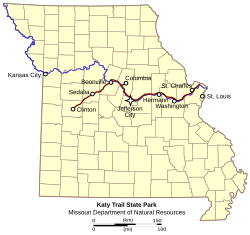Katy Trail State Park
| Katy Trail | |
|---|---|

The Katy Trail (red) and the Missouri River (blue) on a map of Missouri
|
|
| Length | 237.7 mi (382.5 km) |
| Location | Missouri, United States |
| Trailheads |
Machens, Missouri Clinton, Missouri |
| Use | Hiking, Cycling, Horseback |
| Elevation | |
| Elevation change | negligible |
| Highest point | Windsor, Missouri |
| Lowest point | St. Charles, Missouri |
| Hiking details | |
| Trail difficulty | Easy |
| Season | All |
| Sights | Missouri River, Manitou bluffs |
| Hazards |
Severe weather Poison ivy Snakes |
| Website | Katy Trail State Park |
The Katy Trail State Park is a state park in the U.S. state of Missouri that contains the Katy Trail, a recreational rail trail that runs 240 miles (390 km) in the right-of-way of the former Missouri–Kansas–Texas Railroad. Running largely along the northern bank of the Missouri River, it is the country's longest Rails-to-Trails trail. The trail is open for use by hikers, joggers, and cyclists year-round, from sunrise to sunset. Its hard, flat surface is of "limestone pug" (crushed limestone).
The nickname "Katy" comes from the phonetic pronunciation of 'KT' in the railroad's abbreviated name, MKT. Sections of the Katy are also part of the Lewis and Clark National Historic Trail and the American Discovery Trail.
Conversion of right-of-way to a trail was made possible by the National Trails System Act of 1968. In 1982, the city of Columbia opened the MKT Trail on an abandoned spur of the Katy as one of the first rails-to-trails pilot projects in the United States.
On October 4, 1986, floodwater from the Missouri River severely damaged the track along the Missouri–Kansas–Texas Railroad's route from Sedalia to Machens, Missouri. The route had been washed out and repaired many times, but this time, railroad officials decided not to return the tracks to service. Trains were re-routed, and the right-of-way was to be abandoned. The Missouri Department of Natural Resources purchased the right-of-way with a donation from Edward D. "Ted" Jones and Pat Jones of Williamsburg and St. Louis. In 1990, the first segment of the trail officially opened in Rocheport.
...
Wikipedia
